18 Nov WEST COAST INITIATIVES FROM THE IMPULSES OF RUDOLF STEINER
Snapshots from “EverythingFlows”, A Water Conference held in North Vancouver BC at
Cascadia in September 2017
 Jennifer Greene opened the conference by showing us her many-times-taped-together copy of “Sensitive Chaos: The Creation of Flowing Forms in Water and Air” by Theodor Schwenk, an anthroposophist, engineer and pioneering water researcher who founded the Institute for Flow Sciences in Germany. She carries this volume around with her wherever she goes, calling it her “book of mysteries.” Jennifer continues Schwenk’s work at the Water Research Institute located in Blue Hill, Maine.
Jennifer Greene opened the conference by showing us her many-times-taped-together copy of “Sensitive Chaos: The Creation of Flowing Forms in Water and Air” by Theodor Schwenk, an anthroposophist, engineer and pioneering water researcher who founded the Institute for Flow Sciences in Germany. She carries this volume around with her wherever she goes, calling it her “book of mysteries.” Jennifer continues Schwenk’s work at the Water Research Institute located in Blue Hill, Maine.
“Everything about water registers in a single drop,” she said. We each made one with a syringe and then “grew” it and observed what changed and what remained the same. She asked, “What can we say about the intrinsic nature of water?” We noticed among other things that the drop was round and silvery and it quivered.
 We took a drop of tinted water and let it fall into a large jar of clear water. The drop sat on the surface for a nano-second and then changed into a ring as it moved downward. This happened very quickly. The ring expanded with nobs forming and then more rings were formed; we watched with fascination as the rings wafted to the bottom of the jar.
We took a drop of tinted water and let it fall into a large jar of clear water. The drop sat on the surface for a nano-second and then changed into a ring as it moved downward. This happened very quickly. The ring expanded with nobs forming and then more rings were formed; we watched with fascination as the rings wafted to the bottom of the jar.
Someone remarked that the rings seemed to enjoy themselves in their journey downwards.
Water likes to move and likes to keep its roundness. We learned that naturally flowing water endeavours to follow a meandering course with the flow petering out and then becoming a series of drops.
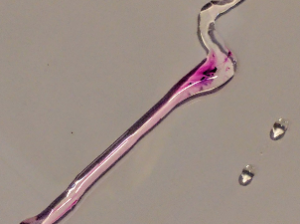 On the second day, we made a “trickle” meander. A grain of potassium permanganate was introduced into a flowing stream. This made the flowing water turn a fuschia colour which allowing us see its movement more clearly. A “bulge” was formed in the stream and we saw a pulsing action.
On the second day, we made a “trickle” meander. A grain of potassium permanganate was introduced into a flowing stream. This made the flowing water turn a fuschia colour which allowing us see its movement more clearly. A “bulge” was formed in the stream and we saw a pulsing action.
We could see two vortices in the bulge —one circled upstream and other, downstream. Someone called out, “It looks like a beating heart!” We learned that water flowing downstream has a counter movement that goes upstream.
Pans of water thickened with a bit of sugar had been placed on the worktables. Drops of dark blue tinted water were dribbled in rows into the pan. We each took a little stick to draw a line of movement through the water. Strong wave-like 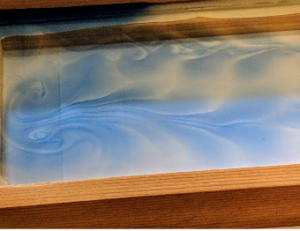 shapes emerged along the line of movement with other wave shapes being formed in other parts of the pan. We discovered that moving water connects; it is open to its surroundings.
shapes emerged along the line of movement with other wave shapes being formed in other parts of the pan. We discovered that moving water connects; it is open to its surroundings.
On Wednesday we made vortices with water in very large jars. We dipped sticks vertically into the water and rotated them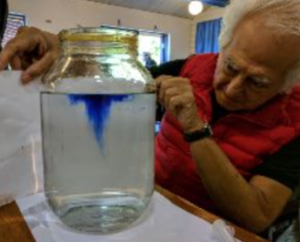 anti-clockwise. Six drops of blue tinted water were dripped into the middle of the whirling vortex. We saw layers of water move vertically and horizontally with a kind of pulsing, breathing movement. Jennifer explained that the “surface area” of the layers of water had increased enormously. When water moves in a vortex it takes the story of what is happening in the cosmos into the environment. This is why the biodynamic preparations work so well. The stirrings create immense areas of activity with the effects being felt for many acres within the farmer’s fields.
anti-clockwise. Six drops of blue tinted water were dripped into the middle of the whirling vortex. We saw layers of water move vertically and horizontally with a kind of pulsing, breathing movement. Jennifer explained that the “surface area” of the layers of water had increased enormously. When water moves in a vortex it takes the story of what is happening in the cosmos into the environment. This is why the biodynamic preparations work so well. The stirrings create immense areas of activity with the effects being felt for many acres within the farmer’s fields.
The next day we observed vortices moving from below upwards. We saw the 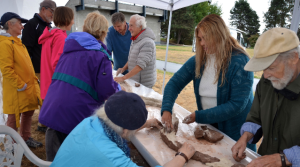 same veils of coloured water move in spirals around the centre of a vortex. Jennifer showed us slides of patterns emerging when a drop of tinted water falls on a surface.
same veils of coloured water move in spirals around the centre of a vortex. Jennifer showed us slides of patterns emerging when a drop of tinted water falls on a surface.
Through-out the four days there were morning workshops— fibre arts, singing, eurythmy and speech and building a clay meander with Jennifer and also Herb Walsh. Companions, coworkers and conference participants worked alongside each other.
In the evenings there were speakers from the community.
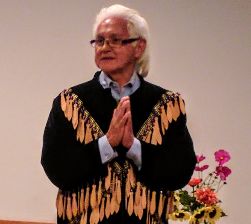 Gary Johnston from the Squamish nation spoke about the connection his people had with water. They made cedar canoes which they paddled back and forth from their summer to their winter homes. Offerings were made to the being of the tree for its sacrifice in the construction of the canoe and ceremonies held with it facing the open water symbolizing the tree’s new life. We learned that in all of Canada there were 50 aboriginal languages (30 plus in BC alone!) and that each of the languages represented a distinct culture.
Gary Johnston from the Squamish nation spoke about the connection his people had with water. They made cedar canoes which they paddled back and forth from their summer to their winter homes. Offerings were made to the being of the tree for its sacrifice in the construction of the canoe and ceremonies held with it facing the open water symbolizing the tree’s new life. We learned that in all of Canada there were 50 aboriginal languages (30 plus in BC alone!) and that each of the languages represented a distinct culture.
Peter Mc Cartney from the Wilderness Committee spoke on another evening about environmental issues around water. Our obsessive use and abuse of oil fuels climate change. When oil is burned carbon is generated, creating a blanket around the earth and warming sea waters. Salmon have difficulty swimming upstream in warm water. Also the water becomes acidic and oysters and lobsters have trouble making their shells. The Wilderness Committee works to educate people towards the practice of using more solar and tidal power to generate power.
Rev. Susan Locey started her talk by saying, “The water in me greets the water in you.” She talked about water as an organism that circulates and continually adjusts itself to its environment. It is one of 7 substances used in the sacraments of the Christian Community. Water is composed of oxygen which is the sun element— bringing life. Hydrogen dissolves life. These two elements overcome their one-sidedness and work together in a new way.
Aiona Anderson from the Nte?kepmx nation grew up with a river flowing in front of her house. At an early age, she was sent to residential schools and could only return home in the summers. She was forbidden to use her language which changed her at the very core of her being. It has been a struggle over the years to heal herself on all levels. Painting with water colour (wet-on-wet) and striving to re-learn her language have helped. Indigenous people “go to the water” if they have difficulty of any sort. For decades the First Nations people have sounded the alarm that the next wars will be fought over water.
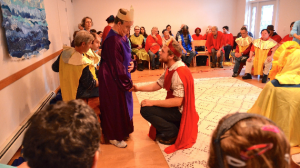 We finished the conference with a performance of The Water of Life, a Grimm’s tale that many people practised over the previous four days. Ruth Tschannen directed the play helped ably by coworker Deepak Virk who narrated events in his booming voice. Deepak grew up in a large East Indian family where he had to make himself loud so that his voice was heard. He was active in his high school theatre program and loves being involved in drama because it brings everyone together.
We finished the conference with a performance of The Water of Life, a Grimm’s tale that many people practised over the previous four days. Ruth Tschannen directed the play helped ably by coworker Deepak Virk who narrated events in his booming voice. Deepak grew up in a large East Indian family where he had to make himself loud so that his voice was heard. He was active in his high school theatre program and loves being involved in drama because it brings everyone together.
It was wonderful to be part of a pageant with companions, coworkers, and other conference participants. We were all in colourful costume acting out events which seemed to originate out of time and space, yet were strangely relevant to the here-and-now. We were mesmerized by what was unfolding in front of us. If there was some sudden need, one of us might be asked to don a costume and play a part at the last minute. Everything flowed.
“Water has much to teach us,” said Jennifer as we wrapped up the conference. It is social; it invites everything along. It is selfless and flexible; it shows how we may behave and act with one another.
We are grateful for the efforts of Ruth Tschannen who masterminded this whole event with help from many people particularly Monique Walsh and Jason Yates. Jennifer wanted everyone to know that she was especially thankful to Herb Walsh for his help with the gathering together and making of the equipment needed each day. There were numerous shopping trips to Home Depot!
Thanks also to Anthony Perzel for the use of some of his photos in this piece.
Well done, everyone!
Susan Koppersmith
